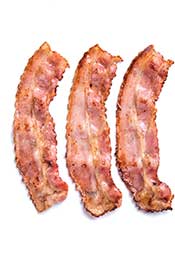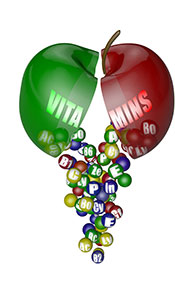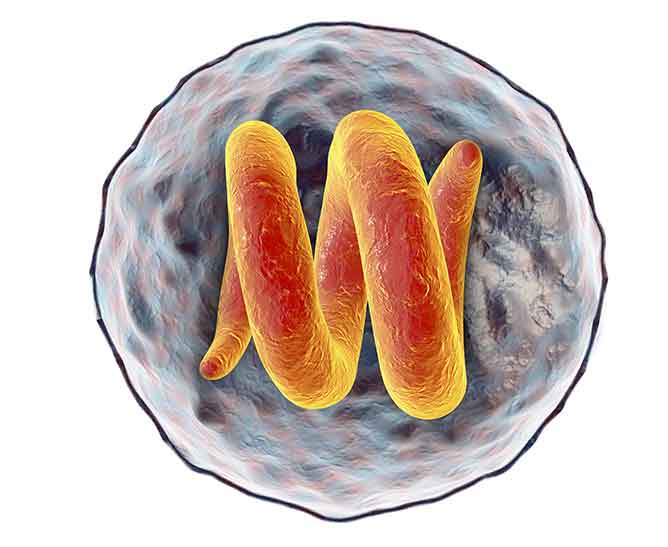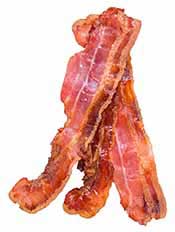
Pork is a nutritious type of meat that provides several important vitamins and minerals.
Additionally, it is a great tasting and affordable source of high-quality protein.
However, there are some common concerns surrounding pork that refuse to disappear.
This article examines the nutrition profile, health benefits, and concerns about the popular meat.
We then answer the central question; is eating pork good or bad for you?
What Is Pork?
Pork refers to the meat from a domestic pig, and it is the most popular type of meat in the world.
In fact, the world consumes more than 100,000 tons of pork every single year.
Although it is sometimes thought to be ‘white meat,’ pork is technically red meat because it contains small amounts of myoglobin.
Myoglobin is a red pigmented protein, and it is responsible for the color of meat.
Pork enjoys popularity as fresh meat and also in a variety of pork products, such as bacon, sausages, and cured meat.
Key Point: Pork is the meat of a domestic pig and it is the most popular type of meat in the world.
Nutrition Facts (Pork Chop)
Before we look at the health benefits and concerns, here are the complete nutritional values for pork.
The tables below show the calorie, macronutrient and micronutrient profile per 100 grams of boneless pork chop.
Calories and Macronutrients
| Nutrient | Amount (Grams / % RDA) |
| Calories | 169 kcal |
| Carbohydrate | – |
| – Fiber | – |
| – Sugar | – |
| Fat | 5.0 g |
| – Saturated Fat | 1.8 g |
| – Monounsaturated Fat | 2.4 g |
| – Polyunsaturated Fat | 0.7 g |
| – Omega-3 Fatty Acids | 19.0 mg |
| – Omega-6 Fatty Acids | 583 mg |
| Protein | 29.0 g |
Pork is an excellent source of protein and contains 29 grams per 100 g.
The majority of pork’s fat content comes from monounsaturated fat, with smaller amounts of saturated and minimal levels of polyunsaturated fat.
It is important to note that this fat content will depend on the specific cut of meat.
For example, pork belly contains over 50 grams of fat while lean cuts of tenderloin provide less than 5 g per 100 grams.
Like all meat, pork contains no carbohydrate.
Micronutrients
Pork is rich in numerous essential vitamins and minerals.
The tables below show the major micronutrients in pork compared to the recommended daily allowance (RDA).
Vitamins
| Vitamin | Amount (% RDA) |
| Thiamin (Vitamin B1) | 42% |
| Niacin (Vitamin B3) | 41% |
| Vitamin B6 | 35% |
| Vitamin B2 | 11% |
| Vitamin B12 | 10% |
| Pantothenic Acid (Vit B5) | 7% |
| Vitamin E | 1% |
Pork meat is a particularly good source of B vitamins.
Minerals
| Nutrient | Amount (% RDA) |
| Selenium | 62% |
| Phosphorus | 23% |
| Zinc | 14% |
| Potassium | 10% |
| Magnesium | 6% |
| Copper | 4% |
| Iron | 3% |
| Sodium | 2% |
| Calcium | 1% |
Pork is an excellent source of selenium, and it contains a decent concentration of phosphorus, zinc and potassium.
Key Point: Pork is a protein-dense food and it is rich in several key nutrients, particularly B vitamins and the mineral selenium.
Health Benefits of Eating Pork

Owing to its nutrient density, eating pork provides several health benefits.
1. High-Quality Source of Protein
Pork meat contains a complete source of protein.
In other words; the meat contains adequate concentrations of every essential amino acid.
100 grams of pork chop contains the essential amino acids in the following concentrations;
- Histidine: 5751 mg
- Isoleucine: 6189 mg
- Leucine: 10387 mg
- Methionine: 3469 mg
- Phenylalanine: 5122 mg
- Threonine: 5171 mg
- Tryptophan: 1212 mg
- Valine: 6574 mg
- Lysine: 11482 mg
Key Point: Pork is a rich source of essential amino acids.
2. Key Source of Nutrients For US Adults
Pork contains a variety of vitamins and minerals, and it is also one of the key providers of crucial nutrients for US adults.
These insights were uncovered by the National Health and Nutrition Examination Survey.
The results demonstrated that, among adults in the United States, pork contributes;
- 16% of total fat.
- Between 23% and 31% of total protein, selenium and thiamin content.
- 11-19% of phosphorus, potassium, riboflavin, nicacin, vitamin B6 and vitamin B12/
- 21% of total zinc intake.
While this specific data is only applicable to the United States, global pork consumption is higher than that of any other meat.
As a result, it is clear that pork contributes substantial amounts of vital nutrients to the human diet across the world.
Key Point: Pork is an important source of nutrients for the American (and worldwide) diet.
3. High in B Vitamins

Pork is one of the primary dietary sources of B vitamins.
Consuming sufficient amounts of the B vitamins is vital for several different reasons.
Firstly, B vitamins play a critical role in the human body by;
- Creating red blood cells.
- Having a vital role in promoting a healthy pregnancy and the proper development of a baby.
- Maintaining healthy cognitive function.
- Playing a major role in energy metabolism; producing energy from the food we eat.
- Regulating the central nervous system.
- Synthesizing fatty acids.
Furthermore, research clearly shows that B vitamin deficiency may lead to anxiety, depression and various types of brain dysfunction.
Vitamin B12 is particularly important for helping to prevent depression.
Key Point: Pork is an excellent source of B vitamins. These compounds are important for our overall health, and deficiencies can cause many problems, particularly for mental health.
4. Pork Contains Glycine and Collagen
Certain parts of pork contain significant amounts of glycine.
The most substantial of these sources is pork skin, which contains 11,919 mg of glycine per 100 grams.
Two everyday pork products that contain glycine are skin-on pork belly and pork rinds/crackling.
Although it is a non-essential amino acid, glycine has several significant health benefits. For one thing, a balanced ratio of glycine and methionine (an amino acid found in muscle meat) appears to hold longevity benefits.
For instance, rat studies show that methionine restriction extends lifespan by 30-40%. However, supplementing with glycine (without restricting methionine) has the same effect.
Humans are not biologically identical to rats of course, but we are not able to do clinical studies on humans in this way.
Collagen
First of all, in combination with the amino acids proline and hydroxyproline, greater glycine intake helps the body to synthesize more collagen.
Also, gelatinous cuts of pork contain large amounts of pre-formed collagen.
Research demonstrates that consuming sufficient dietary collagen helps to strengthen and keep hair, skin and joints healthy.
Key Point: Collagen and glycine can help to improve skin health, and greater glycine intake may have potential longevity benefits.
5. Substantial Source of Selenium

Pork contains substantial concentrations of the mineral selenium.
Although deficiency is relatively rare in developed countries, selenium deficiency affects around 1 billion people worldwide.
Furthermore, various plant foods may contain less selenium than in the past due to selenium depletion in agricultural soil.
On the positive side, a 6 oz (170 g) pork chop contains more than 100% of the recommended daily allowance for selenium.
Maintaining sufficient levels of selenium is especially crucial for proper thyroid function.
Key Point: Pork contains large amounts of selenium, an essential mineral that plays a key role in thyroid health.
Health Concerns
Similar to most foods, there are some health concerns about pork too.
These range from the fatty acid profile to potential parasitic bacteria that the meat can carry.
1. Parasitic Diseases (Trichinosis and Yersiniosis)

Eating contaminated (and undercooked) pork meat is a risk factor for a parasitic disease known as trichinosis.
Trichinosis is caused by a particular species of roundworm bacteria that can infect (and enter) our intestines, muscles, and even organs.
Symptoms of trichinosis may include nausea, abdominal pain, and inflammation of our muscles (including the heart).
While these symptoms sound horrible, trichinosis is a rare disease and only affects around 10,000 people per year – worldwide.
Fortunately, this scary disease is easily preventable by ensuring pork is adequately cooked. Cooking pork to a temperature of 163°F (71°C) is sufficient to kill any parasites that may be present.
Another similar infection is caused by eating undercooked pork contaminated with Yersinia enterocolitica bacteria. These bacteria cause the infection known as yersiniosis.
Although it is more common than trichinosis, yersiniosis usually subsides by itself without medical treatment.
Key Point: There are several parasitic diseases associated with eating undercooked contaminated pork. However, we can avoid them by ensuring we take care to cook pork meat properly.
2. Pork Has a High Omega-6 to 3 Ratio
In modern times, we are all overeating omega-6 relative to our omega-3 intake.
Markedly, this excessive swing in the balance toward the pro-inflammatory omega-6 may cause inflammation-related health problems.
Compared to other red meats like beef and lamb, pork has a much higher ratio of omega-6 to 3.
For example, the average omega-6 to 3 ratio from pork chops, ground pork and pork tenderloin is 24 to 1.
In contrast, beef and lamb can be as low as 3 to 1.
Does It Matter?
I think the high omega-6 content of pork may not matter too much, depending on the overall diet.
If somebody is already eating large amounts of omega-6 vegetable oils (like soy, corn and rice bran oil) then adding fatty cuts of pork is not ideal.
On the other hand, if someone already restricts vegetable oils and consumes omega-3 rich oily fish, then it may not matter as much.
The high omega-6 in pork only really affects fatty cuts of pork like bacon and belly pork (more than 5 g of omega-6 fatty acids per 100 grams).
Leaner cuts of pork like tenderloin contain minimal levels of omega-6 (<500 mg per 100 grams).
Key Point: Fatty cuts of pork contain significant amounts of omega-6 polyunsaturated fat. Depending on the overall diet, this may be a concern for the omega 6 to 3 ratio.
3. Some Pork Products Contain Nitrates and Nitrites

Pork products like bacon and some cuts of cured meat may contain nitrates and nitrites.
Nitrates and nitrites are a type of chemical preservative commonly used in processed meat.
Some epidemiological research suggests there is a link between processed meat and gastrointestinal cancers.
While there does seem to be an association between processed meat consumption and gastric cancer risk, there are also several confounding factors to consider.
For example; is it the processed meat which is a problem, or is it the overall dietary pattern of people eating processed meat?
The definition of ‘processed meat’ can also wildly differ, and it could refer to a pastry product containing processed meat, or it could be traditional fermented meat products like salami and prosciutto.
That said, a recent meta-analysis suggests that “high consumption” of nitrites could increase cancer risk. However, the researchers add that “considering confounding factors, we could not absolutely confirm the reliability of these findings”.
If nitrates/nitrites are a concern, then traditionally salt-cured pork products are available which do not contain these preservatives.
Key Point: Epidemiology links preservatives in processed meat products to gastric cancers. However, there is currently no proof of causation.
4. Pork and Chronic Disease Risks
Does pork increase our risk for chronic diseases?
Pork and Type 2 Diabetes
In a systematic review, studies did not show an adverse effect on diabetes risk from fresh pork consumption. There were even some beneficial impacts such as increased high-density lipoprotein (HDL) levels.
Conversely, processed meat led to larger insulin responses than fresh meat.
However, “the findings are weak and there is a lack of solid evidence”.
Pork and Cancer Risk
Aside from the preservative issue, another potential mechanism for increased cancer risk revolves around high-heat cooking practices.
For example, overcooking (charring) pork can generate specific compounds known as polycyclic aromatic hydrocarbons (PAHs) and heterocyclic amines (HCAs).
These compounds are seen as “probable human carcinogens”.
While there is no conclusive proof of causation, it is probably better to employ gentle cooking methods and avoid burning pork – or any other meat.
Interestingly, using herbs, spices or red wine with meat can reduce the formation of these compounds by up to 88%.
Pork and Cardiovascular Disease (CVD)
There are very little clinical studies on pork and CVD risk.
However, a recent systematic review of clinical trials found that there was no major difference in markers of CVD risk between high and low intakes of red meat.
Key Point: There is no causative proof that pork can increase chronic disease risk. However, it is probably prudent to avoid burning meat.
Is Pork Good or Bad For You?
The nutritional data demonstrates that pork meat is rich in a variety of essential nutrients.
Further, studies have shown that pork plays a significant contribution to meeting key nutrient requirements in the human diet.
While there are some health concerns, we can overcome most of these by employing sensible cooking practices.
For all these reasons, pork can play a tasty role in a healthy diet.
Source: Article by Michael Joseph (https://www.nutritionadvance.com/is-pork-good-or-bad-for-you/)
